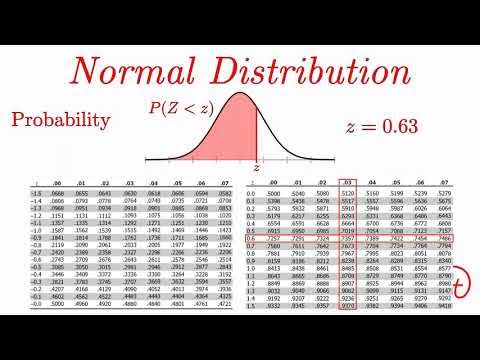What is a Bell Curve or Normal Curve Explained?
Summary
TLDRThe video script explains the bell curve, also known as the normal curve, a probability distribution used in statistics and psychology to analyze data. It highlights the curve's characteristics: the mean is centrally located, it's unimodal with one peak, and has predictable standard deviations (68%, 95%, and 99.7% of data fall within 1, 2, and 3 standard deviations from the mean, respectively). The bell curve's symmetrical shape is used in IQ testing and is periodically restandardized to account for societal changes like the Flynn effect.
Takeaways
- 📊 A bell curve, or normal curve, is a statistical tool used to represent data distribution in a symmetrical bell shape.
- 🔴 The mean of the data set is always at the center of the bell curve, indicating the average value.
- 🏔️ Bell curves are unimodal, meaning they have a single peak, which is different from bimodal or multimodal distributions.
- 📊 The curve's standard deviations are predictable and symmetrical, typically represented as SD, with percentages associated with each deviation.
- 🔢 Approximately 68% of the data falls within one standard deviation from the mean.
- 🔢 About 95% of the data falls within two standard deviations from the mean.
- 🔢 Almost all (99.7%) of the data falls within three standard deviations from the mean.
- 📏 The bell curve's symmetry is a key characteristic, making it useful for understanding the distribution of various measurements like height, weight, or aptitudes.
- 🧠 Bell curves are often used in IQ testing to illustrate the distribution of intelligence scores, with most scores clustering around the mean.
- 📉 Intelligence tests are periodically restandardized to account for societal changes, such as the Flynn effect, which reflects an increase in intelligence over time.
Q & A
What is a bell curve or normal curve?
-A bell curve, also known as a normal curve, is a graphical representation of a probability distribution that creates a bell-shaped graph. It is commonly used in statistics and psychology to analyze sets of data.
What are the characteristics of a bell curve?
-The characteristics of a bell curve include having the mean at the center, being unimodal (having one peak), having predictable standard deviations, and being symmetrical.
Why is the mean always at the center of a bell curve?
-In a bell curve, the mean is at the center because it represents the average value of the data set, and the curve is symmetrically distributed around this central point.
What does it mean for a bell curve to be unimodal?
-A bell curve is unimodal because it has only one peak, indicating that the majority of the data points are clustered around a single central value.
How do standard deviations relate to a bell curve?
-Standard deviations in a bell curve are predictable and symmetrically distributed around the mean. They measure the dispersion of data points from the mean, with 68%, 95%, and 99.7% of the data falling within one, two, and three standard deviations, respectively.
What percentage of scores typically fall within one standard deviation from the mean in a bell curve?
-In a bell curve, 68% of the scores typically fall within one standard deviation from the mean.
How is the bell curve used in IQ testing?
-The bell curve is used in IQ testing to illustrate the distribution of IQ scores, with most scores falling between one and two standard deviations from the mean, representing the average intelligence range.
What is the significance of the Flynn effect in the context of bell curves and IQ testing?
-The Flynn effect refers to the observed increase in intelligence over the past several years. Intelligence tests are periodically restandardized to account for this effect, ensuring that the bell curve distribution remains representative of current intelligence levels.
Why is it important to restandardize intelligence tests?
-Restandardizing intelligence tests is important to ensure that the bell curve accurately reflects current population intelligence levels, accounting for factors like the Flynn effect, which could otherwise skew the distribution.
What does the symmetry of a bell curve indicate about the data?
-The symmetry of a bell curve indicates that the data is evenly distributed around the mean, with equal proportions of data points on either side of the center, reflecting a balanced and predictable distribution.
Can you provide an example of how a bell curve might be used outside of IQ testing?
-A bell curve can be used to represent the distribution of various measurable traits such as height, weight, or aptitudes, where the majority of the population falls within a certain range around the mean, with fewer individuals at the extremes.
Outlines

This section is available to paid users only. Please upgrade to access this part.
Upgrade NowMindmap

This section is available to paid users only. Please upgrade to access this part.
Upgrade NowKeywords

This section is available to paid users only. Please upgrade to access this part.
Upgrade NowHighlights

This section is available to paid users only. Please upgrade to access this part.
Upgrade NowTranscripts

This section is available to paid users only. Please upgrade to access this part.
Upgrade NowBrowse More Related Video

Types Of Distribution In Statistics | Probability Distribution Explained | Statistics | Simplilearn

Peluang Distribusi NORMAL beserta Contoh Soal Pembahasan

Metode Statistika | Sebaran Peluang Kontinu | Mengenal Sebaran Normal

Normal Distribution EXPLAINED with Examples

Distribusi Probabilitas Normal

Distribusi Normal | Konsep Dasar dan Sifat Kurva Normal | Matematika Peminatan Kelas 12
5.0 / 5 (0 votes)